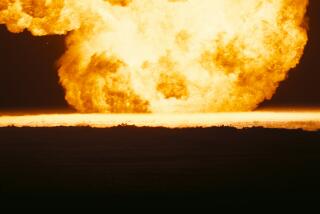Kai Siegbahn, 89; Nobel-winning physicist invented electron spectroscopy for chemical analysis
Kai Siegbahn, the Swedish physicist who shared the 1981 Nobel Prize in physics for inventing a now widely used technique for studying the surface chemistry of metals and other materials, died of a heart attack July 20 at his summer cabin in Angelholm in southern Sweden. He was 89.
The technique Siegbahn invented, called electron spectroscopy for chemical analysis, or ESCA, is widely used for nondestructive assays of corrosion of metal surfaces, wear on prostheses, identification of contaminants on electrical circuits and many other industrial applications.
It relies on the so-called photo-electric effect, which was discovered in the 1880s by German physicist Heinrich Hertz and explained in 1905 by Albert Einstein. When ultraviolet light or X-rays are directed at a material, the material emits electrons.
The energy of those electrons is equal to the energy of the light that struck the material minus the energy with which the electrons were bound to their atoms, and thus reveals information about not only the identity of atoms in the material but also their chemical environment.
Early attempts to analyze the energy of the electrons were largely unsuccessful, however. The electron spectrographs were composed of broad bands that contained little information because the electrons collided with other atoms on their way out of the material, losing varying amounts of energy, and the technique was largely abandoned.
As a graduate student in the 1940s, Siegbahn was studying the energy of electrons emitted by the beta decay of radioactive nuclei, which presented a similar problem. To overcome the problem, he devised a mushroom-shaped magnet that was able to focus the electrons in two directions.
This double-focusing improved the sensitivity of the instrument tenfold, revealing a great deal of information about the nature of the nuclei.
During the 1950s, Siegbahn and his colleagues Carl Nordling and Evelyn Sokolowski built a double-focusing spectrometer to study photoelectrons.
In 1957, for the first time, they observed strong and extremely narrow lines from electrons that had left the sample without energy loss.
These lines were present in the earlier studies, but the high resolution of their instrument made it possible to see them. As was the case in radioactive decay, their instrument improved sensitivity tenfold.
During the next decade, Siegbahn also showed that the positions of the lines for a given element were shifted slightly depending on its chemical environment. He found, for example, that the lines were subtly different for sulfur depending on whether it existed as a sulfide or a sulfate.
His work changed electron spectroscopy from a rarely used laboratory curiosity to a common industrial technique.
In 1981, he received half of the Nobel Prize in physics for his work. The other half went to physicists Nicolaas Bloembergen of Harvard University and Arthur L. Schawlow of Stanford University for the development of laser spectroscopy.
Siegbahn was one of four father-son pairs to win the physics Nobel. His father, Karl Manne George Siegbahn, won it in 1924 for his studies of X-ray spectroscopy. Reflecting on his heritage, Kai Siegbahn said, “It’s a decided advantage if you start discussing physics every day at breakfast.”
Kai Siegbahn was probably one of the few physicists who had a good idea when he would receive the award. He was a longtime member of the Royal Swedish Academy of Sciences, which chooses the Nobel laureates. In 1981, his colleagues asked him not to take part in the deliberations, a strong sign that he was under consideration.
But he said he had no idea. “I had no advance indication I would be receiving it,” he said. “The winner always comes as a surprise.”
Kai Manne Siegbahn was born April 20, 1918, in Lund, Sweden. He received his bachelor’s and master’s degrees from the University of Uppsala and his doctorate from the University of Stockholm.
After brief interludes at the Nobel Institute of Physics and the Royal Institute of Technology in Stockholm, he returned to Uppsala, where he spent the rest of his career. He officially retired in 1984 but continued working in his laboratory until his death, his wife said.
He is survived by his wife, Anna Brita Siegbahn, and three sons, Per, Hans and Nils. Per and Hans are physicists.
thomas.maugh@latimes.com
More to Read
Start your day right
Sign up for Essential California for the L.A. Times biggest news, features and recommendations in your inbox six days a week.
You may occasionally receive promotional content from the Los Angeles Times.






